Cloud Upgrade for Organizational Efficiency: Case Study
VerifiedAdded on 2020/06/03
|10
|2541
|54
AI Summary
This technical report investigates the network upgrade of an organization that shifted from using an outdated Windows Server 2008 setup with basic LAN, router, switch, and ad hoc connections to a modern cloud-based system. The transition was driven by the need to manage increasing numbers of employees and computers efficiently. Key changes included upgrading network hardware to fiber optic cables for faster data transmission and layer 3 switches for improved speed and connectivity. The report provides an overview of the upgrade process, its impact on organizational efficiency, enhanced security features, and a cost estimation for implementing these technological advancements.
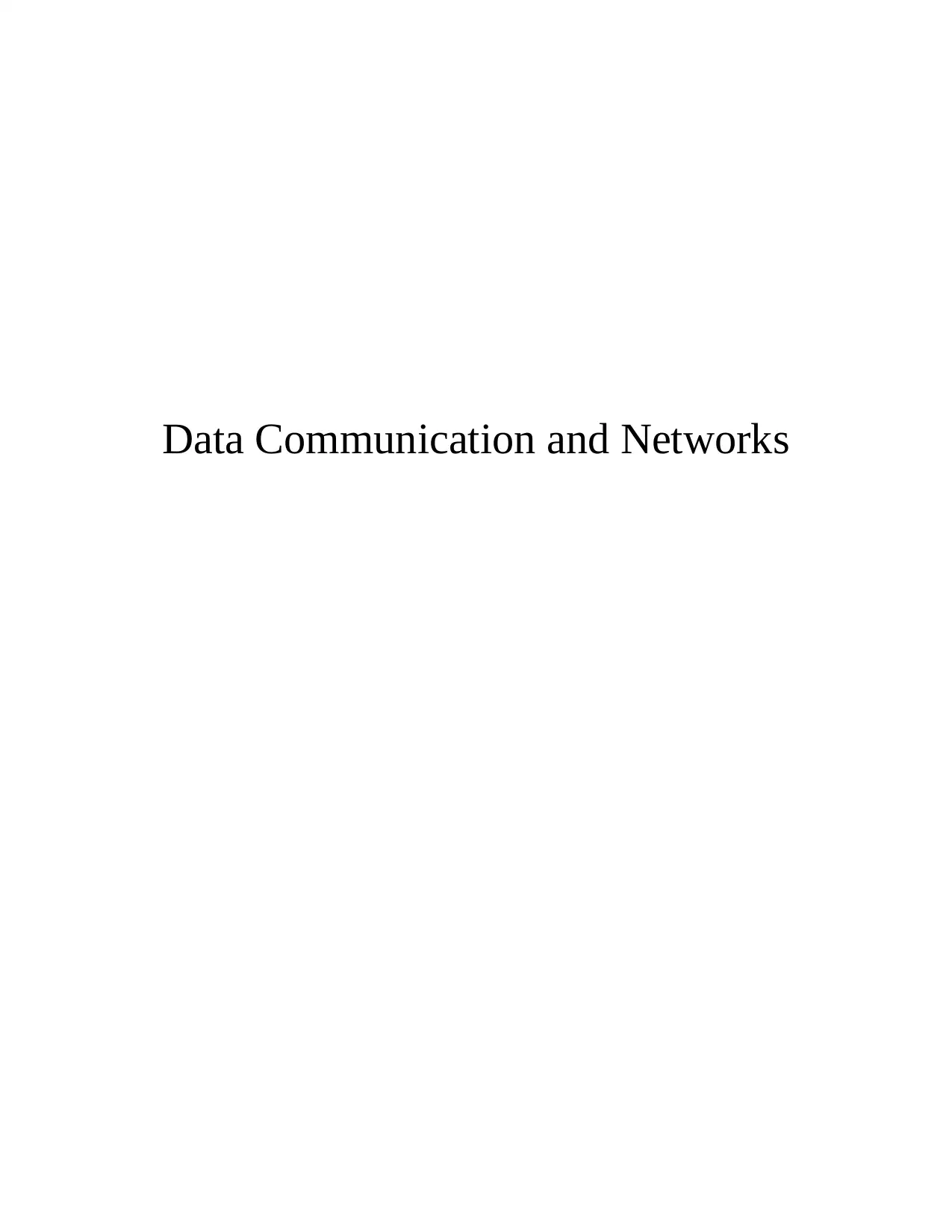
Data Communication and Networks
Paraphrase This Document
Need a fresh take? Get an instant paraphrase of this document with our AI Paraphraser
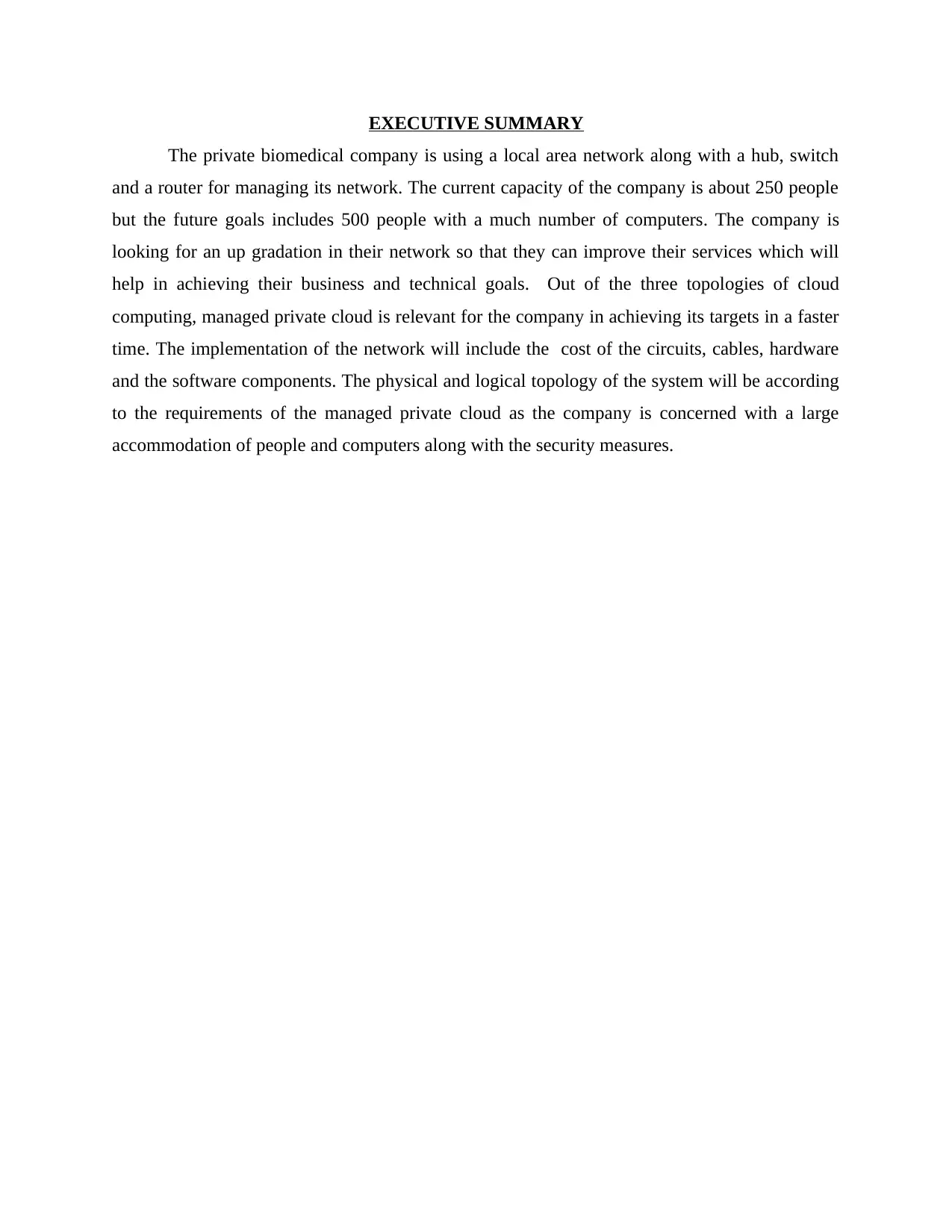
EXECUTIVE SUMMARY
The private biomedical company is using a local area network along with a hub, switch
and a router for managing its network. The current capacity of the company is about 250 people
but the future goals includes 500 people with a much number of computers. The company is
looking for an up gradation in their network so that they can improve their services which will
help in achieving their business and technical goals. Out of the three topologies of cloud
computing, managed private cloud is relevant for the company in achieving its targets in a faster
time. The implementation of the network will include the cost of the circuits, cables, hardware
and the software components. The physical and logical topology of the system will be according
to the requirements of the managed private cloud as the company is concerned with a large
accommodation of people and computers along with the security measures.
The private biomedical company is using a local area network along with a hub, switch
and a router for managing its network. The current capacity of the company is about 250 people
but the future goals includes 500 people with a much number of computers. The company is
looking for an up gradation in their network so that they can improve their services which will
help in achieving their business and technical goals. Out of the three topologies of cloud
computing, managed private cloud is relevant for the company in achieving its targets in a faster
time. The implementation of the network will include the cost of the circuits, cables, hardware
and the software components. The physical and logical topology of the system will be according
to the requirements of the managed private cloud as the company is concerned with a large
accommodation of people and computers along with the security measures.
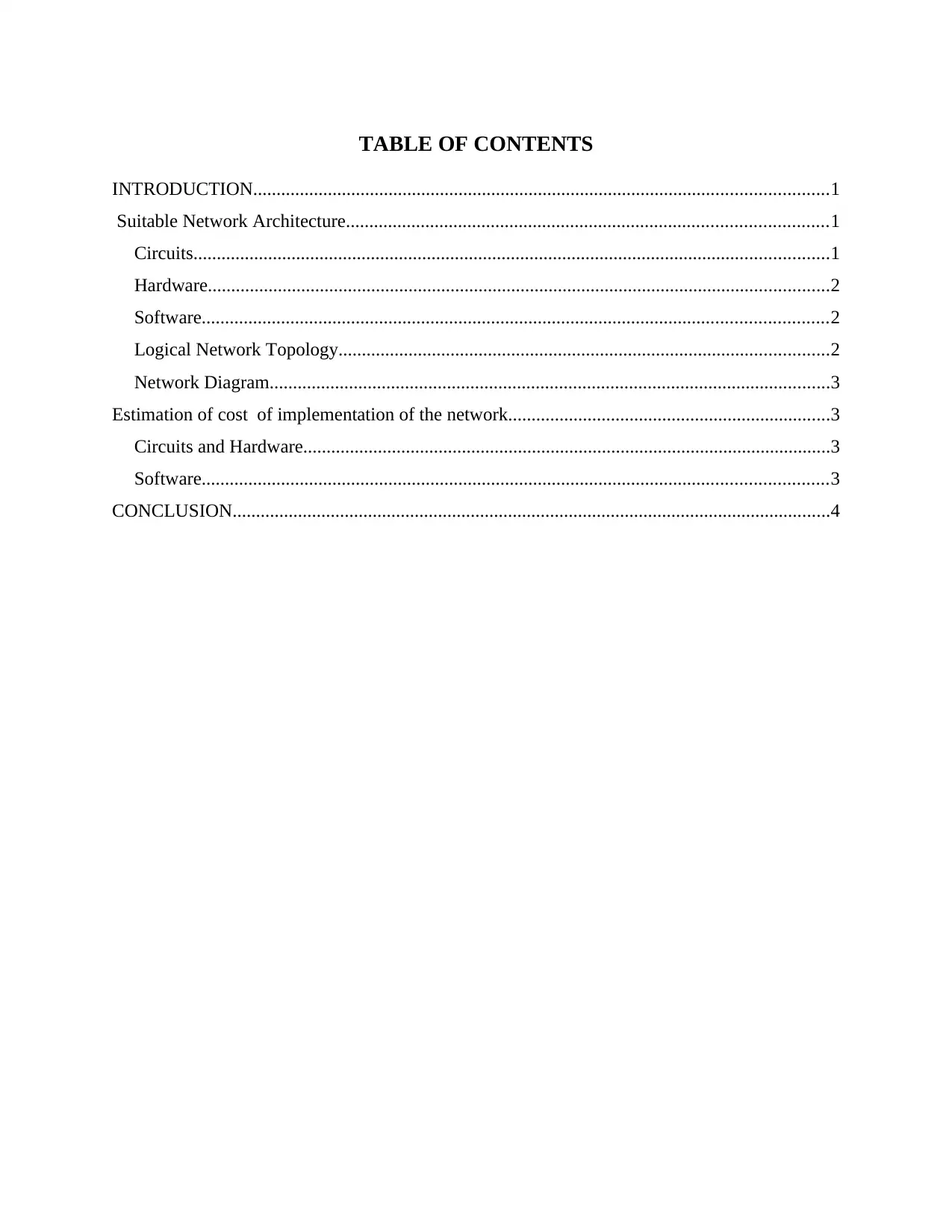
TABLE OF CONTENTS
INTRODUCTION...........................................................................................................................1
Suitable Network Architecture.......................................................................................................1
Circuits........................................................................................................................................1
Hardware.....................................................................................................................................2
Software......................................................................................................................................2
Logical Network Topology.........................................................................................................2
Network Diagram........................................................................................................................3
Estimation of cost of implementation of the network.....................................................................3
Circuits and Hardware.................................................................................................................3
Software......................................................................................................................................3
CONCLUSION................................................................................................................................4
INTRODUCTION...........................................................................................................................1
Suitable Network Architecture.......................................................................................................1
Circuits........................................................................................................................................1
Hardware.....................................................................................................................................2
Software......................................................................................................................................2
Logical Network Topology.........................................................................................................2
Network Diagram........................................................................................................................3
Estimation of cost of implementation of the network.....................................................................3
Circuits and Hardware.................................................................................................................3
Software......................................................................................................................................3
CONCLUSION................................................................................................................................4
⊘ This is a preview!⊘
Do you want full access?
Subscribe today to unlock all pages.

Trusted by 1+ million students worldwide

INTRODUCTION
Data communication can be considered as channelling, which means sending and
receiving data and information between any two bodies by the means of electronic waves or
signals. These bodies can be internal as well as external and the signals can also act as analog or
digital. In this communication, data is being exchanged in form of 0 or 1 bit as data transmission
deals with the binary language (Pahlavan and Krishnamurthy, 2011). The effectiveness of a
system relies on three main factors which includes the accuracy, delivery, and the time.
Networking is categorised as the construction and representation of a network which includes the
involvement of various hardware and software components. The report is about the up-gradation
of the network in a biomedical private company for achieving future business and technical
goals.
Suitable Network Architecture
As the current status of the company is that it has only two dedicated room for
computers, each with a capacity of 10 computers. The company has two buildings adjacent to
each other having a distance of 40 metres in between. Additional 20 computers are also there in
the second building for the administrative staff. The network, they are using is a simple hub,
switch and a server. The operating system being used is windows server 2008. The network also
includes three LAN connections with a single router. The current strength of the company is 250
employees, but their future goal is to accommodate 500 employees along with a more number of
computers, and also to be able to set up videoconference between the two buildings and the
branch, which is located at a distance of 200 km (McNamara, 2014). The up-gradation of the
network will include various components such as cables, hardware, switches etc. and these are
discussed as under:
Circuits
Layer 3 Switches
Usually the network switches operate at Layer 2 switches but the routers of the network
operate at Layer 3 switches. It is also called as multi-layer switch and is considered as a
specialized sort of hardware. The specialization of this type of switch is its ways of performing
the routing decisions. It will help the company in not experiencing any latency in the network.
AS the company is using a LAN network, it can be upgraded to a cloud computing technology in
1
Data communication can be considered as channelling, which means sending and
receiving data and information between any two bodies by the means of electronic waves or
signals. These bodies can be internal as well as external and the signals can also act as analog or
digital. In this communication, data is being exchanged in form of 0 or 1 bit as data transmission
deals with the binary language (Pahlavan and Krishnamurthy, 2011). The effectiveness of a
system relies on three main factors which includes the accuracy, delivery, and the time.
Networking is categorised as the construction and representation of a network which includes the
involvement of various hardware and software components. The report is about the up-gradation
of the network in a biomedical private company for achieving future business and technical
goals.
Suitable Network Architecture
As the current status of the company is that it has only two dedicated room for
computers, each with a capacity of 10 computers. The company has two buildings adjacent to
each other having a distance of 40 metres in between. Additional 20 computers are also there in
the second building for the administrative staff. The network, they are using is a simple hub,
switch and a server. The operating system being used is windows server 2008. The network also
includes three LAN connections with a single router. The current strength of the company is 250
employees, but their future goal is to accommodate 500 employees along with a more number of
computers, and also to be able to set up videoconference between the two buildings and the
branch, which is located at a distance of 200 km (McNamara, 2014). The up-gradation of the
network will include various components such as cables, hardware, switches etc. and these are
discussed as under:
Circuits
Layer 3 Switches
Usually the network switches operate at Layer 2 switches but the routers of the network
operate at Layer 3 switches. It is also called as multi-layer switch and is considered as a
specialized sort of hardware. The specialization of this type of switch is its ways of performing
the routing decisions. It will help the company in not experiencing any latency in the network.
AS the company is using a LAN network, it can be upgraded to a cloud computing technology in
1
Paraphrase This Document
Need a fresh take? Get an instant paraphrase of this document with our AI Paraphraser

which layer 3 switches can be used for the connections between the WTPs and access controller
(ACs) as it acts as a main and critical component of the architecture of a cloud computing
technology.
Hardware
Most of the times, these networks are positioned in the infrastructure mode. In this, the
base station acts as a wireless access point hub and all the nodes make communication with the
help of hub only. The hub may or may not have a fibre or wired connection (Conti and Giordano,
2014). But the company can include fibre optics for the connection. The fibre optics cable can
exchange more data within a specific period of time than the other cables such as copper wire
etc. Also, it can help the company in achieving their goal of protecting the company information
as it provides high security of the data (Richardson, Fini and Nelson, 2013). The company has an
issue that they cannot use internet on their laptops, instead the employees have to use the data
connection on the computers itself. So, by the application of fibre optics and wireless clients, the
people inside the company may be able to connect the access point for joining the network on
their personal devices such as laptops, mobile phones, iPads etc.
Software
The company after upgrading from the LAN to the cloud computing technologies, can
refer to Software as a service (SaaS). It is considered as an on-demand software and can be used
as a pay according the use and through a subscription free. It is a very well-known model for
security management. So, this software can also fulfil the business goal of the company in
getting a much-secured environment for their data and information along with the personal
details of the company and its employees.
Logical Network Topology
As the company have upgraded from a local area network to a cloud computing network,
this upgraded model focuses on creating a pool of several servers along with the information
centres which can help the users in accessing the stored information and services when required.
The forte of the company behind using cloud computing is to complete its two main activities
which includes enabling the activities of the pool as a virtual resource that acts single and then
connecting the users to the resources, no matter what and how far the location is. There are
2
(ACs) as it acts as a main and critical component of the architecture of a cloud computing
technology.
Hardware
Most of the times, these networks are positioned in the infrastructure mode. In this, the
base station acts as a wireless access point hub and all the nodes make communication with the
help of hub only. The hub may or may not have a fibre or wired connection (Conti and Giordano,
2014). But the company can include fibre optics for the connection. The fibre optics cable can
exchange more data within a specific period of time than the other cables such as copper wire
etc. Also, it can help the company in achieving their goal of protecting the company information
as it provides high security of the data (Richardson, Fini and Nelson, 2013). The company has an
issue that they cannot use internet on their laptops, instead the employees have to use the data
connection on the computers itself. So, by the application of fibre optics and wireless clients, the
people inside the company may be able to connect the access point for joining the network on
their personal devices such as laptops, mobile phones, iPads etc.
Software
The company after upgrading from the LAN to the cloud computing technologies, can
refer to Software as a service (SaaS). It is considered as an on-demand software and can be used
as a pay according the use and through a subscription free. It is a very well-known model for
security management. So, this software can also fulfil the business goal of the company in
getting a much-secured environment for their data and information along with the personal
details of the company and its employees.
Logical Network Topology
As the company have upgraded from a local area network to a cloud computing network,
this upgraded model focuses on creating a pool of several servers along with the information
centres which can help the users in accessing the stored information and services when required.
The forte of the company behind using cloud computing is to complete its two main activities
which includes enabling the activities of the pool as a virtual resource that acts single and then
connecting the users to the resources, no matter what and how far the location is. There are
2
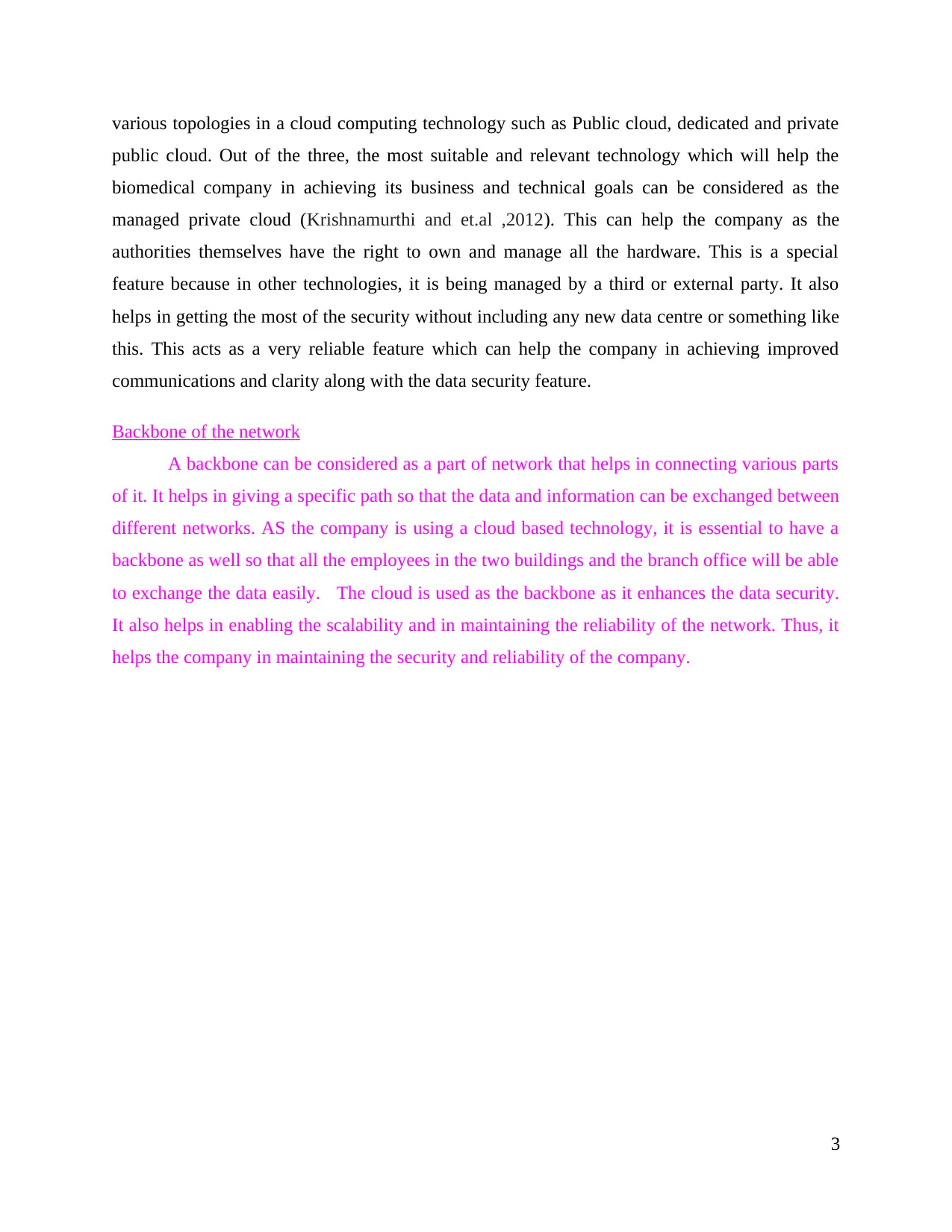
various topologies in a cloud computing technology such as Public cloud, dedicated and private
public cloud. Out of the three, the most suitable and relevant technology which will help the
biomedical company in achieving its business and technical goals can be considered as the
managed private cloud (Krishnamurthi and et.al ,2012). This can help the company as the
authorities themselves have the right to own and manage all the hardware. This is a special
feature because in other technologies, it is being managed by a third or external party. It also
helps in getting the most of the security without including any new data centre or something like
this. This acts as a very reliable feature which can help the company in achieving improved
communications and clarity along with the data security feature.
Backbone of the network
A backbone can be considered as a part of network that helps in connecting various parts
of it. It helps in giving a specific path so that the data and information can be exchanged between
different networks. AS the company is using a cloud based technology, it is essential to have a
backbone as well so that all the employees in the two buildings and the branch office will be able
to exchange the data easily. The cloud is used as the backbone as it enhances the data security.
It also helps in enabling the scalability and in maintaining the reliability of the network. Thus, it
helps the company in maintaining the security and reliability of the company.
3
public cloud. Out of the three, the most suitable and relevant technology which will help the
biomedical company in achieving its business and technical goals can be considered as the
managed private cloud (Krishnamurthi and et.al ,2012). This can help the company as the
authorities themselves have the right to own and manage all the hardware. This is a special
feature because in other technologies, it is being managed by a third or external party. It also
helps in getting the most of the security without including any new data centre or something like
this. This acts as a very reliable feature which can help the company in achieving improved
communications and clarity along with the data security feature.
Backbone of the network
A backbone can be considered as a part of network that helps in connecting various parts
of it. It helps in giving a specific path so that the data and information can be exchanged between
different networks. AS the company is using a cloud based technology, it is essential to have a
backbone as well so that all the employees in the two buildings and the branch office will be able
to exchange the data easily. The cloud is used as the backbone as it enhances the data security.
It also helps in enabling the scalability and in maintaining the reliability of the network. Thus, it
helps the company in maintaining the security and reliability of the company.
3
⊘ This is a preview!⊘
Do you want full access?
Subscribe today to unlock all pages.

Trusted by 1+ million students worldwide

Network physical topology with network diagram
This can be considered as the network physical diagram in which the infrastructure is
connected in both the ways. In one way, it is being connected with the access point of the Wi-Fi
and on the other side, it is being connected with the firewall (Conti and Giordano, 2014). It helps
in preventing the systems and protecting the data. With the firewall, different components are
attached which includes the web services, Microsoft active synchronisation and the content
servers. With the access point, an operating system has been connected. The operating system
can be either iOS or any android version. With the infrastructure, there is also a mobile network
connected. As the topology of cloud computing provides three categories, the diagram above
depicts the representation of the managed private network (Kaminow, L and Willner, 2010). All
the services and operations, along with the security measures are being managed by the
4
Illustration 1: Physical topology diagram for the company
(Source: Network diagram software, 2017)
This can be considered as the network physical diagram in which the infrastructure is
connected in both the ways. In one way, it is being connected with the access point of the Wi-Fi
and on the other side, it is being connected with the firewall (Conti and Giordano, 2014). It helps
in preventing the systems and protecting the data. With the firewall, different components are
attached which includes the web services, Microsoft active synchronisation and the content
servers. With the access point, an operating system has been connected. The operating system
can be either iOS or any android version. With the infrastructure, there is also a mobile network
connected. As the topology of cloud computing provides three categories, the diagram above
depicts the representation of the managed private network (Kaminow, L and Willner, 2010). All
the services and operations, along with the security measures are being managed by the
4
Illustration 1: Physical topology diagram for the company
(Source: Network diagram software, 2017)
Paraphrase This Document
Need a fresh take? Get an instant paraphrase of this document with our AI Paraphraser
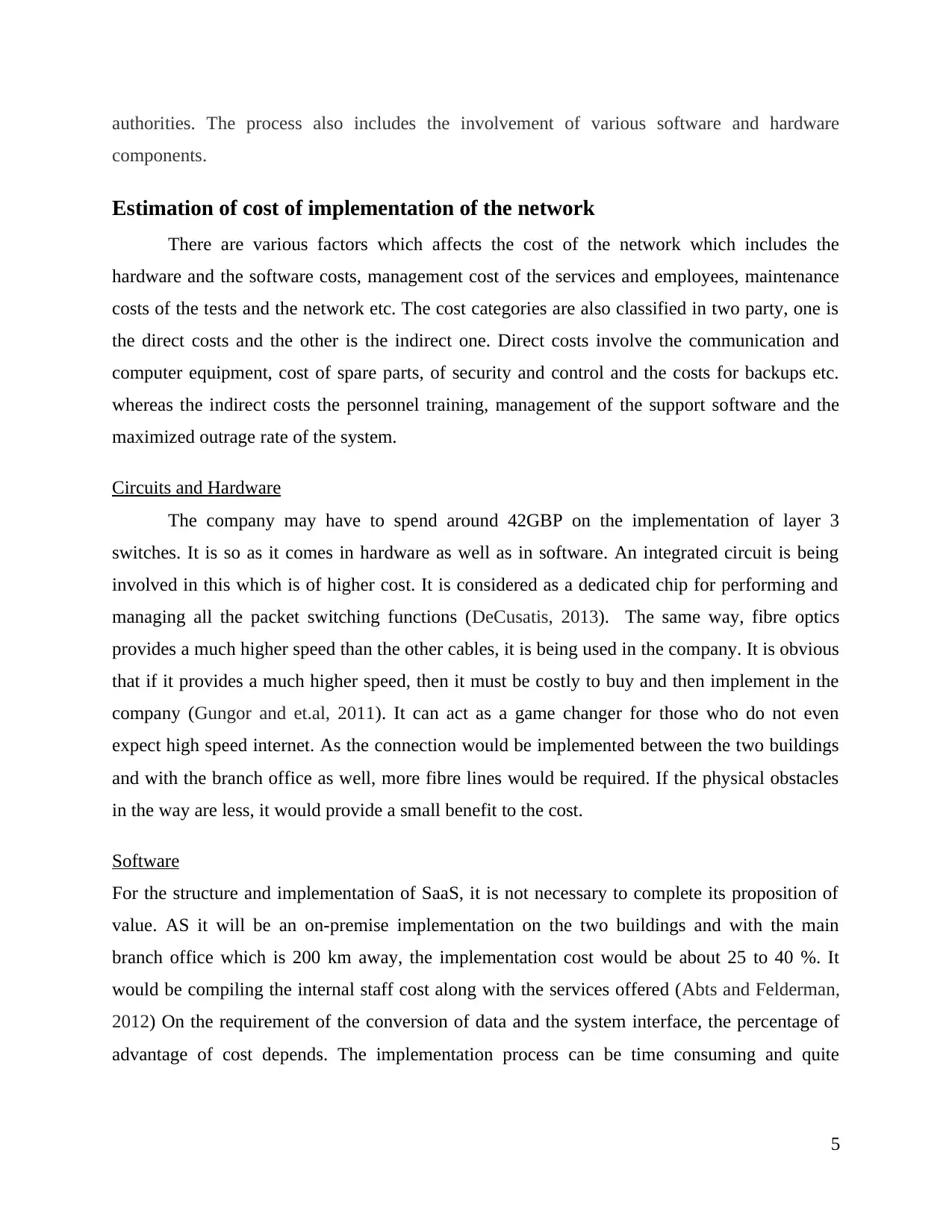
authorities. The process also includes the involvement of various software and hardware
components.
Estimation of cost of implementation of the network
There are various factors which affects the cost of the network which includes the
hardware and the software costs, management cost of the services and employees, maintenance
costs of the tests and the network etc. The cost categories are also classified in two party, one is
the direct costs and the other is the indirect one. Direct costs involve the communication and
computer equipment, cost of spare parts, of security and control and the costs for backups etc.
whereas the indirect costs the personnel training, management of the support software and the
maximized outrage rate of the system.
Circuits and Hardware
The company may have to spend around 42GBP on the implementation of layer 3
switches. It is so as it comes in hardware as well as in software. An integrated circuit is being
involved in this which is of higher cost. It is considered as a dedicated chip for performing and
managing all the packet switching functions (DeCusatis, 2013). The same way, fibre optics
provides a much higher speed than the other cables, it is being used in the company. It is obvious
that if it provides a much higher speed, then it must be costly to buy and then implement in the
company (Gungor and et.al, 2011). It can act as a game changer for those who do not even
expect high speed internet. As the connection would be implemented between the two buildings
and with the branch office as well, more fibre lines would be required. If the physical obstacles
in the way are less, it would provide a small benefit to the cost.
Software
For the structure and implementation of SaaS, it is not necessary to complete its proposition of
value. AS it will be an on-premise implementation on the two buildings and with the main
branch office which is 200 km away, the implementation cost would be about 25 to 40 %. It
would be compiling the internal staff cost along with the services offered (Abts and Felderman,
2012) On the requirement of the conversion of data and the system interface, the percentage of
advantage of cost depends. The implementation process can be time consuming and quite
5
components.
Estimation of cost of implementation of the network
There are various factors which affects the cost of the network which includes the
hardware and the software costs, management cost of the services and employees, maintenance
costs of the tests and the network etc. The cost categories are also classified in two party, one is
the direct costs and the other is the indirect one. Direct costs involve the communication and
computer equipment, cost of spare parts, of security and control and the costs for backups etc.
whereas the indirect costs the personnel training, management of the support software and the
maximized outrage rate of the system.
Circuits and Hardware
The company may have to spend around 42GBP on the implementation of layer 3
switches. It is so as it comes in hardware as well as in software. An integrated circuit is being
involved in this which is of higher cost. It is considered as a dedicated chip for performing and
managing all the packet switching functions (DeCusatis, 2013). The same way, fibre optics
provides a much higher speed than the other cables, it is being used in the company. It is obvious
that if it provides a much higher speed, then it must be costly to buy and then implement in the
company (Gungor and et.al, 2011). It can act as a game changer for those who do not even
expect high speed internet. As the connection would be implemented between the two buildings
and with the branch office as well, more fibre lines would be required. If the physical obstacles
in the way are less, it would provide a small benefit to the cost.
Software
For the structure and implementation of SaaS, it is not necessary to complete its proposition of
value. AS it will be an on-premise implementation on the two buildings and with the main
branch office which is 200 km away, the implementation cost would be about 25 to 40 %. It
would be compiling the internal staff cost along with the services offered (Abts and Felderman,
2012) On the requirement of the conversion of data and the system interface, the percentage of
advantage of cost depends. The implementation process can be time consuming and quite
5

complex, so it would be requiring more resources to stay on, so it directly affects the cost of
implementation (Carofiglio and et.al, 2011).
CONCLUSION
It can be concluded from the report that the private biomedical company was using a hub,
switch and a router as their network along with a LAN connected to the router. The company
was using a very old version of Windows Server 2008, which also contributed to the speed of
their internet connection. The organisation upgraded to cloud based computing so that in their
future business goals, they could be able to manage about 500 employees along with a large
number of computers. The use of cloud computing provided various security features to the
company which can help them in managing well the data of the organisation along with the
personal data of the employees. It included various hardware and software components, out of
which layer 3 switches and fibre optic cable were used for a better speed and fine connection.
The estimation of implementation of the cables along with the hardware and software
components have also been done.
6
implementation (Carofiglio and et.al, 2011).
CONCLUSION
It can be concluded from the report that the private biomedical company was using a hub,
switch and a router as their network along with a LAN connected to the router. The company
was using a very old version of Windows Server 2008, which also contributed to the speed of
their internet connection. The organisation upgraded to cloud based computing so that in their
future business goals, they could be able to manage about 500 employees along with a large
number of computers. The use of cloud computing provided various security features to the
company which can help them in managing well the data of the organisation along with the
personal data of the employees. It included various hardware and software components, out of
which layer 3 switches and fibre optic cable were used for a better speed and fine connection.
The estimation of implementation of the cables along with the hardware and software
components have also been done.
6
⊘ This is a preview!⊘
Do you want full access?
Subscribe today to unlock all pages.

Trusted by 1+ million students worldwide

REFERENCES
Books and Journals
Abts, D. and Felderman, B., 2012. A guided tour of data-center networking. Communications of
the ACM. 55(6). pp.44-51.
Carofiglio, G. and et.al., 2011, September. Modelling data transfer in content-centric networking.
In Proceedings of the 23rd international tele traffic congress (pp. 111-118). International
Tele traffic Congress.
Conti, M. and Giordano, S., 2014. Mobile ad hoc networking: milestones, challenges, and new
research directions. IEEE Communications Magazine. 52(1). pp.85-96.
DeCusatis, C. ed., 2013. Handbook of fiber optic data communication: a practical guide to
optical networking. Academic Press.
Gungor, V.C. And et.al., 2011. Smart grid technologies: Communication technologies and
standards. IEEE transactions on Industrial informatics. 7(4). pp.529-539.
Kaminow, I., Li, T. and Willner, A. E., 2010. Optical fibre telecommunications VB: systems and
networks. Elsevier.
Krishnamurthi, R. and et.al., Qualcomm Incorporated, 2012. Method and apparatus for testing
traffic and auxiliary channels in a wireless data communication system. U.S. Patent
8,089,888.
McNamara, J.E., 2014. Technical aspects of data communication. Digital Press.
Meisel, M., Pappas, V. and Zhang, L., 2010, September. Ad hoc networking via named data.
In Proceedings of the fifth ACM international workshop on Mobility in the evolving
internet architecture (pp. 3-8). ACM.
Pahlavan, K. and Krishnamurthy, P., 2011. Principles of wireless networks: A unified approach.
Prentice Hall PTR.
Richardson, D. J., Fini, J. M. and Nelson, L. E., 2013. Space-division multiplexing in optical
fibres. Nature Photonics. 7(5). pp.354-362.
Online
Network diagram software., 2017. [Online]. Available through:
<http://www.conceptdraw.com/How-To-Guide/ISG-network-diagram>. [Accesses on 5th October
2017].
7
Books and Journals
Abts, D. and Felderman, B., 2012. A guided tour of data-center networking. Communications of
the ACM. 55(6). pp.44-51.
Carofiglio, G. and et.al., 2011, September. Modelling data transfer in content-centric networking.
In Proceedings of the 23rd international tele traffic congress (pp. 111-118). International
Tele traffic Congress.
Conti, M. and Giordano, S., 2014. Mobile ad hoc networking: milestones, challenges, and new
research directions. IEEE Communications Magazine. 52(1). pp.85-96.
DeCusatis, C. ed., 2013. Handbook of fiber optic data communication: a practical guide to
optical networking. Academic Press.
Gungor, V.C. And et.al., 2011. Smart grid technologies: Communication technologies and
standards. IEEE transactions on Industrial informatics. 7(4). pp.529-539.
Kaminow, I., Li, T. and Willner, A. E., 2010. Optical fibre telecommunications VB: systems and
networks. Elsevier.
Krishnamurthi, R. and et.al., Qualcomm Incorporated, 2012. Method and apparatus for testing
traffic and auxiliary channels in a wireless data communication system. U.S. Patent
8,089,888.
McNamara, J.E., 2014. Technical aspects of data communication. Digital Press.
Meisel, M., Pappas, V. and Zhang, L., 2010, September. Ad hoc networking via named data.
In Proceedings of the fifth ACM international workshop on Mobility in the evolving
internet architecture (pp. 3-8). ACM.
Pahlavan, K. and Krishnamurthy, P., 2011. Principles of wireless networks: A unified approach.
Prentice Hall PTR.
Richardson, D. J., Fini, J. M. and Nelson, L. E., 2013. Space-division multiplexing in optical
fibres. Nature Photonics. 7(5). pp.354-362.
Online
Network diagram software., 2017. [Online]. Available through:
<http://www.conceptdraw.com/How-To-Guide/ISG-network-diagram>. [Accesses on 5th October
2017].
7
1 out of 10
Related Documents
Your All-in-One AI-Powered Toolkit for Academic Success.
+13062052269
info@desklib.com
Available 24*7 on WhatsApp / Email
![[object Object]](/_next/static/media/star-bottom.7253800d.svg)
Unlock your academic potential
Copyright © 2020–2025 A2Z Services. All Rights Reserved. Developed and managed by ZUCOL.





